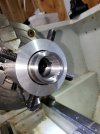Jeffrthehunter
Well-Known Member
I am in the process of blue printing a Remington action (first time). I have ordered a recoil lug with two pre drilled pin holes and a 1.075" hole for oversized threads. I have the action threads opened up to 1.075" and plan on running a barrel tenon diameter of 1.074". Using my mill I was going to dial in the action threads, move over and center drill and drill for pins (.001" oversized for slip fit). I realize that there is a chance alignment will not be perfect and I may have interference with tenon diameter and 1.075" bore in recoil lug. So here is my question, should I run the tenon (just the diameter where lug locates) down to say 1.070" so there will be room for error? I feel like lug will locate off pins, no reason to make everything so tight. Any thoughts would be appreciated! Thanks Jeff

